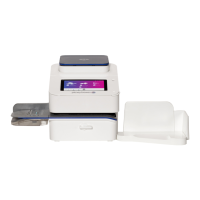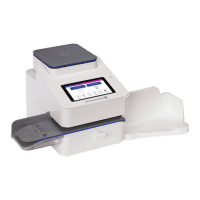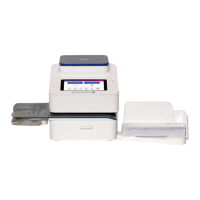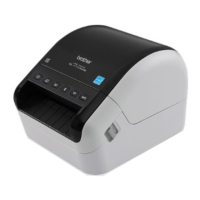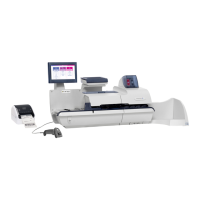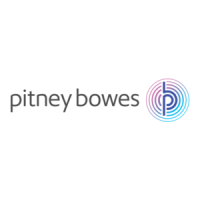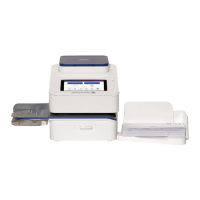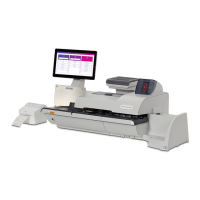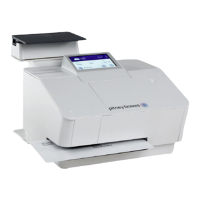Do you have a question about the Pitney Bowes SendPro C Auto and is the answer not in the manual?
Locate your device's Product Code Number (PCN) and 7-digit serial number on the label.
Access shipping labels or postage printing from the SendPro C Auto Home screen.
Instructions on how to create and print shipping labels using the device.
Assign shipping label costs to accounts for tracking postage expenses.
Create an account to track costs for printing postage on envelopes.
Procedure for automatically feeding envelopes into the SendPro C Auto.
Steps for sending standard postcards, letters, and large envelopes via First-Class Mail.
Utilize USPS Certified Mail service for proof of mailing.
Obtain proof of mailing for letters or packages using USPS Certificate of Mailing.
How to add postage to your device for printing on envelopes.
Instructions for sealing envelopes and printing postage simultaneously.
Procedure for replacing the ink cartridge when the low ink warning appears.
Print a test pattern to check printhead and ink cartridge functionality.
Store commonly used settings like class, account, and graphics as presets.
Order necessary supplies, such as ink cartridges, directly from the device.
Connect your SendPro C Auto to the Pitney Bowes Data Center using a network cable.
Connect your SendPro C Auto to a wireless network.
Remove a Wi-Fi network connection from your device.
Use the Network Connection app to diagnose network issues.
Locate MAC addresses for both wired and wireless network connections.
Configure proxy server settings for network access.
Set or remove a PIN to prevent unauthorized use of your device.
Modify location code and time zone settings for device or scale changes.
Customize the display brightness to suit your workspace.
Add frequently used apps to the Home screen for easier access.
Configure energy saver settings to reduce power consumption.
Preview mail and manage packages using the USPS Informed Delivery service.
Upload system logs to a Pitney Bowes support representative for troubleshooting.
Log in to your shipping labels account and sign out when finished.
Create and print shipping labels for various carriers like USPS, UPS, or FedEx.
Compare shipping rates from different carriers for mailpieces or packages.
Add additional sender addresses to the Address Book for shipping labels.
Modify existing sender addresses within the device's address book.
Print international shipping labels, including customs information.
Generate a return shipping label for items being sent back to you.
Print USPS SCAN forms to simplify label scanning for shipments.
Reprint USPS, UPS, or FedEx shipping labels if the original did not print correctly.
Cancel UPS or FedEx shipping labels to prevent postage charges.
Request a refund for USPS shipping labels under specific conditions.
Add, edit, and delete addresses for shipping labels.
Track shipping label expenses by assigning accounts to labels.
Set or change the default amount for refilling shipping label postage.
Assign shipping label costs to accounts for charge-back purposes.
Enable address autofill for easier address entry when creating shipping labels.
Add single or import multiple addresses to the shipping labels address book.
Overview of managing cost accounts: enabling, adding, and editing.
Modify the description, status, or make an existing cost account default.
Process for refilling postage for your shipping labels account.
Configure device alerts for pending shipping label postage refills.
Configure your FedEx account for use with shipping labels.
Configure your UPS account for use with shipping labels.
Define default print options for shipping labels, including size and receipt printing.
Configure email notifications for tracking, delivery, and refunds.
Set a default recipient address for all USPS return labels.
View shipment reports to track postage spending by carrier and amount.
Contact support to remove funds from your device accounts.
Access the Envelope Printing or Print on Envelopes app.
Print postage onto tape strips for application on envelopes.
View the available postage funds on your device.
Add postage to your device for envelope printing.
Steps for mailing standard postcards, letters, and large envelopes.
Determine mailpiece type and select rates for large envelopes.
Use USPS Certified Mail for proof of mailing.
Process for mailing letters from the United States to other countries.
Obtain proof of mailing for letters or packages from the USPS.
Advance the print date on postage up to thirty days before mailing.
Print postage without a date on pre-printed return envelopes or labels.
Add extra postage directly to an envelope or on a tape strip.
Reprint postage with a future date if mail pickup was missed.
Select additional USPS services like Certified Mail or Insured Mail.
Enter mailpiece weight manually when not using a scale.
Weigh mail using the scale to calculate correct postage.
Use Seal Only mode to seal envelopes without printing postage.
Seal envelopes using the moistener before printing postage.
Set the scale to zero weight before weighing mail.
Purchase insurance for mailpieces to protect against loss or damage.
Add standard graphic images like logos or slogans to postage prints.
Utilize Electronic Return Receipt (ERR) for tracking mailpieces.
Request a refund for mail printed incorrectly or damaged.
Create personalized text messages for mailpieces, up to 5 lines.
Check for the latest postal rates and software updates for your meter.
Set or change the default postage refill amount for envelopes.
Manually upload postage transactions to the Pitney Bowes Data Center.
Reset the piece counter to delete mailpiece count information.
Complete balance inquiries or postage refills for postal inspections.
Ensure your device has the latest postal rates and software automatically.
Check the effective date of the latest postal rates downloaded to your device.
Set a warning threshold for available postage funds.
Enter your 9-digit Mailer ID for Electronic Return Receipt (ERR).
Ensure the correct ZIP code is printed on mailpieces.
Understand the accounting feature for tracking postage usage by department.
Protect accounts from unauthorized access by enabling or disabling passwords.
Create accounts to track postage costs for envelope printing.
Modify account details such as name, description, status, or password.
Prevent postage charges against an account by setting its status to inactive.
Remove an account from the system; data cannot be recovered.
Store commonly used settings as presets for quick recall.
Access and view saved presets for printing postage.
Quickly apply a group of saved settings using a preset.
Rename, replace default, or delete existing presets.
Configure the timer for resetting the device to default commonly-used settings.
Access receipts for previous postage refills.
View total postage spent and the number of pieces printed.
Review a report of all your postage refill history.
Generate a report showing mailpieces sent, device usage, and batch details.
Generate reports on postage spending for specific or all accounts.
Email account reports to track departmental or client postage expenses.
Define start and end dates for account report periods.
Select account level (Account, Sub, Sub-sub) and identification method (Name/Code).
View and print reports of past shipping labels with details like date and carrier.
View and print USPS shipping label refunds requested on the device.
Perform a test print to check the quality of postage printed on envelopes or tape.
Resolve tape errors or jams by following on-screen instructions.
Print a test pattern to verify printhead and ink cartridge functionality.
View the remaining ink level to ensure sufficient ink for printing.
Procedure for replacing the ink cartridge when low ink is detected.
Purchase and replace the ink waste pad when it becomes full.
Clean the printhead if print quality issues persist after nozzle cleaning.
Install a new printhead if the existing one produces poor print quality.
Clean the moistener brush and wick assembly for proper envelope sealing.
Refill the moistener tank with E-Z Seal solution for envelope sealing.
Instructions for loading envelopes into the feeder for automatic feeding.
Safe procedures for moving the device to a new location.
Order supplies like ink cartridges and cleaning kits through the Supplies app.
List of available supplies, ink cartridges, and options with item numbers.
Follow basic requirements for your USPS-licensed postage device.
Understand how USPS requires postage calculation using a scale.
Identify elements within the meter impression that identify the mailer.
Check the installed SendPro software version on your device.
Information about the Postal Security Device (PSD) securing postage funds.
Familiarize yourself with the different parts of the SendPro C Auto.
Identify the ports available on the back of your device.
Review technical specifications including power, temperature, sound, and dimensions.
Details on envelope sizes, flap depth, thickness, weight, and tape size.
Information needed and how to contact Pitney Bowes Technical Support.
Information on proper recycling or disposal of the lithium ion battery.
Access Agency Compliance Information via the product's user guide.
Follow normal safety precautions for office equipment operation.
Special handling notice for perchlorate material in batteries for California customers.
List of third party software incorporated into the product and their licenses.
Locate your device's Product Code Number (PCN) and 7-digit serial number on the label.
Access shipping labels or postage printing from the SendPro C Auto Home screen.
Instructions on how to create and print shipping labels using the device.
Assign shipping label costs to accounts for tracking postage expenses.
Create an account to track costs for printing postage on envelopes.
Procedure for automatically feeding envelopes into the SendPro C Auto.
Steps for sending standard postcards, letters, and large envelopes via First-Class Mail.
Utilize USPS Certified Mail service for proof of mailing.
Obtain proof of mailing for letters or packages using USPS Certificate of Mailing.
How to add postage to your device for printing on envelopes.
Instructions for sealing envelopes and printing postage simultaneously.
Procedure for replacing the ink cartridge when the low ink warning appears.
Print a test pattern to check printhead and ink cartridge functionality.
Store commonly used settings like class, account, and graphics as presets.
Order necessary supplies, such as ink cartridges, directly from the device.
Connect your SendPro C Auto to the Pitney Bowes Data Center using a network cable.
Connect your SendPro C Auto to a wireless network.
Remove a Wi-Fi network connection from your device.
Use the Network Connection app to diagnose network issues.
Locate MAC addresses for both wired and wireless network connections.
Configure proxy server settings for network access.
Set or remove a PIN to prevent unauthorized use of your device.
Modify location code and time zone settings for device or scale changes.
Customize the display brightness to suit your workspace.
Add frequently used apps to the Home screen for easier access.
Configure energy saver settings to reduce power consumption.
Preview mail and manage packages using the USPS Informed Delivery service.
Upload system logs to a Pitney Bowes support representative for troubleshooting.
Log in to your shipping labels account and sign out when finished.
Create and print shipping labels for various carriers like USPS, UPS, or FedEx.
Compare shipping rates from different carriers for mailpieces or packages.
Add additional sender addresses to the Address Book for shipping labels.
Modify existing sender addresses within the device's address book.
Print international shipping labels, including customs information.
Generate a return shipping label for items being sent back to you.
Print USPS SCAN forms to simplify label scanning for shipments.
Reprint USPS, UPS, or FedEx shipping labels if the original did not print correctly.
Cancel UPS or FedEx shipping labels to prevent postage charges.
Request a refund for USPS shipping labels under specific conditions.
Add, edit, and delete addresses for shipping labels.
Track shipping label expenses by assigning accounts to labels.
Set or change the default amount for refilling shipping label postage.
Assign shipping label costs to accounts for charge-back purposes.
Enable address autofill for easier address entry when creating shipping labels.
Add single or import multiple addresses to the shipping labels address book.
Overview of managing cost accounts: enabling, adding, and editing.
Modify the description, status, or make an existing cost account default.
Process for refilling postage for your shipping labels account.
Configure device alerts for pending shipping label postage refills.
Configure your FedEx account for use with shipping labels.
Configure your UPS account for use with shipping labels.
Define default print options for shipping labels, including size and receipt printing.
Configure email notifications for tracking, delivery, and refunds.
Set a default recipient address for all USPS return labels.
View shipment reports to track postage spending by carrier and amount.
Contact support to remove funds from your device accounts.
Access the Envelope Printing or Print on Envelopes app.
Print postage onto tape strips for application on envelopes.
View the available postage funds on your device.
Add postage to your device for envelope printing.
Steps for mailing standard postcards, letters, and large envelopes.
Determine mailpiece type and select rates for large envelopes.
Use USPS Certified Mail for proof of mailing.
Process for mailing letters from the United States to other countries.
Obtain proof of mailing for letters or packages from the USPS.
Advance the print date on postage up to thirty days before mailing.
Print postage without a date on pre-printed return envelopes or labels.
Add extra postage directly to an envelope or on a tape strip.
Reprint postage with a future date if mail pickup was missed.
Select additional USPS services like Certified Mail or Insured Mail.
Enter mailpiece weight manually when not using a scale.
Weigh mail using the scale to calculate correct postage.
Use Seal Only mode to seal envelopes without printing postage.
Seal envelopes using the moistener before printing postage.
Set the scale to zero weight before weighing mail.
Purchase insurance for mailpieces to protect against loss or damage.
Add standard graphic images like logos or slogans to postage prints.
Utilize Electronic Return Receipt (ERR) for tracking mailpieces.
Request a refund for mail printed incorrectly or damaged.
Create personalized text messages for mailpieces, up to 5 lines.
Check for the latest postal rates and software updates for your meter.
Set or change the default postage refill amount for envelopes.
Manually upload postage transactions to the Pitney Bowes Data Center.
Reset the piece counter to delete mailpiece count information.
Complete balance inquiries or postage refills for postal inspections.
Ensure your device has the latest postal rates and software automatically.
Check the effective date of the latest postal rates downloaded to your device.
Set a warning threshold for available postage funds.
Enter your 9-digit Mailer ID for Electronic Return Receipt (ERR).
Ensure the correct ZIP code is printed on mailpieces.
Understand the accounting feature for tracking postage usage by department.
Protect accounts from unauthorized access by enabling or disabling passwords.
Create accounts to track postage costs for envelope printing.
Modify account details such as name, description, status, or password.
Prevent postage charges against an account by setting its status to inactive.
Remove an account from the system; data cannot be recovered.
Store commonly used settings as presets for quick recall.
Access and view saved presets for printing postage.
Quickly apply a group of saved settings using a preset.
Rename, replace default, or delete existing presets.
Configure the timer for resetting the device to default commonly-used settings.
Access receipts for previous postage refills.
View total postage spent and the number of pieces printed.
Review a report of all your postage refill history.
Generate a report showing mailpieces sent, device usage, and batch details.
Generate reports on postage spending for specific or all accounts.
Email account reports to track departmental or client postage expenses.
Define start and end dates for account report periods.
Select account level (Account, Sub, Sub-sub) and identification method (Name/Code).
View and print reports of past shipping labels with details like date and carrier.
View and print USPS shipping label refunds requested on the device.
Perform a test print to check the quality of postage printed on envelopes or tape.
Resolve tape errors or jams by following on-screen instructions.
Print a test pattern to verify printhead and ink cartridge functionality.
View the remaining ink level to ensure sufficient ink for printing.
Procedure for replacing the ink cartridge when low ink is detected.
Purchase and replace the ink waste pad when it becomes full.
Clean the printhead if print quality issues persist after nozzle cleaning.
Install a new printhead if the existing one produces poor print quality.
Clean the moistener brush and wick assembly for proper envelope sealing.
Refill the moistener tank with E-Z Seal solution for envelope sealing.
Instructions for loading envelopes into the feeder for automatic feeding.
Safe procedures for moving the device to a new location.
Order supplies like ink cartridges and cleaning kits through the Supplies app.
List of available supplies, ink cartridges, and options with item numbers.
Follow basic requirements for your USPS-licensed postage device.
Understand how USPS requires postage calculation using a scale.
Identify elements within the meter impression that identify the mailer.
Check the installed SendPro software version on your device.
Information about the Postal Security Device (PSD) securing postage funds.
Familiarize yourself with the different parts of the SendPro C Auto.
Identify the ports available on the back of your device.
Review technical specifications including power, temperature, sound, and dimensions.
Details on envelope sizes, flap depth, thickness, weight, and tape size.
Information needed and how to contact Pitney Bowes Technical Support.
Information on proper recycling or disposal of the lithium ion battery.
Access Agency Compliance Information via the product's user guide.
Follow normal safety precautions for office equipment operation.
Special handling notice for perchlorate material in batteries for California customers.
List of third party software incorporated into the product and their licenses.
| Print Speed | Up to 120 letters per minute |
|---|---|
| Connectivity | USB, Ethernet, Wi-Fi |
| Power Source | AC power |
| Compatibility | Windows, Mac |
| Shipping Carriers | USPS, UPS, FedEx |
| Printing Technology | Thermal inkjet |
| Maximum Label Width | 4 inches |
| Supported Mail Classes | Priority Mail, Priority Mail Express |
| Maximum Envelope Size | 12.5 x 15 inches |
| Sealing Method | Automatic |
